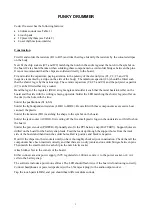
MOTIF XF Reference Manual
Tone Generator Block
9
Basic Str
uct
ur
e
Basic Oper
ation
Connections
Basic Section
Tone Generator Block
The tone generator block is what actually produces sound in response to the MIDI messages received from the Sequencer
block, the Controller block, the Arpeggio block and from the external MIDI instrument via the MIDI IN connector or the USB
connector. The structure of the tone generator block differs depending on the mode.
Tone Generator block in the Voice
Mode
In this mode, the tone generator block receives MIDI data
over a single channel. This status is referred to as a “single
timbre” tone generator. A Voice is played from the
keyboard, using a single part.
Keep in mind that song data on an external sequencer
consisting of multiple MIDI channels will not play back
properly in this mode. If you are using an external MIDI
sequencer or computer to play the instrument, make sure
to use the Song mode or Pattern mode.
A program that contains the sonic elements for generating
a specific musical instrument sound is referred to as a
“Voice.” Internally, there are two Voice Types: Normal
Voices and Drum Voices. Normal Voices are mainly pitched
musical instrument type sounds that can be played over
the range of the keyboard. Drum Voices are mainly
percussion/drum sounds that are assigned to individual
notes on the keyboard.
n
For instructions on editing a Normal Voice, see page 53. For
instructions on editing a Drum Voice, see page 84.
Normal Voice
This is a Voice which is played conventionally from the
keyboard, with standard pitches sounding for each key. A
Normal Voice consists of up to eight Elements. Depending
on the settings in the Voice Edit mode, these Elements are
sounded simultaneously, or the different Elements are
sounded according to the note range, velocity range and
the XA (Expanded Articulation) settings.
The illustration below is an example of a Normal Voice.
Since the six Elements here are distributed across both the
note range of the keyboard and the velocity range, a
different Element sounds depending on which note you
play and how strongly you play it. In the note distribution,
Elements 1 and 2 sound in the lower range of the
keyboard, Elements 3 and 4 sound in the middle range,
and Elements 5 and 6 sound in the higher range. In the
velocity distribution, Elements 1, 3 and 5 sound when
playing the keyboard softly, while Elements 2, 4 and 6
sound when playing it strongly. In a practical example of
this in use, a piano Voice could be composed of six
different samples. Elements 1, 3 and 5 would be the
sounds of the piano played softly, over the respective note
ranges, while Elements 2, 4 and 6 would be strongly
played sounds, for each respective note range. Actually,
the MOTIF XF is even more flexible than this, since it allows
up to eight independent Elements.
Drum Voice (Drum Kit)
Drum Voices are mainly percussion/drum sounds that are
assigned to individual notes on the keyboard. A collection
of assigned percussion/drum waves or Normal Voices is
known as a Drum Kit.
Expanded Articulation (XA) is a specially designed tone
generation system that provides greater performance
flexibility and acoustic realism. It allows you to more
effectively recreate realistic sound and natural
performance techniques—such as legato and staccato—
and provides other unique modes for random and alternate
sound changes as you play.
Realistic legato performance
Conventional synthesizers recreate a legato effect by
continuing the volume envelope of a previous note on to
the next one, in the mono mode. However, this results in an
unnatural sound different from that of an actual acoustic
instrument. The MOTIF XF more accurately reproduces a
legato effect by allowing specific Elements to be sounded
when playing legato and other Elements to be played
Part structure in the Voice mode
Voice
Normal Voices & Drum Voices
Expanded Articulation (XA)
Velocity
Element 1
Element 2
Element 3
Element 4
Element 5
Element 6
Key 1
Key 5 Key 10 Key 18 Key 21
Key 73
C0
C1
C6
Individual
drum sounds
(different for
each key)










































